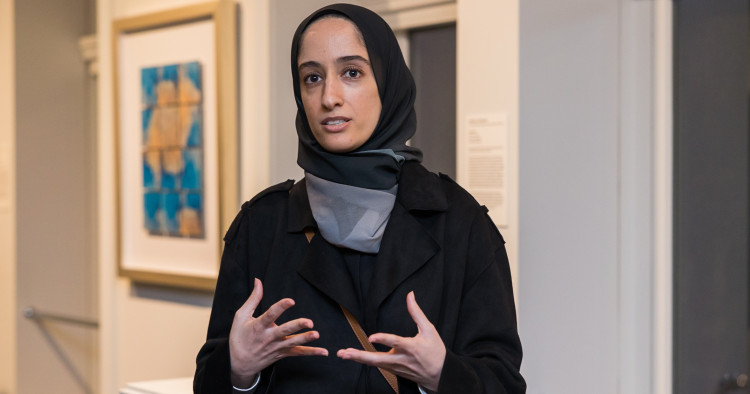In the village of Barbar, Bahrain, lie the ruins of three Sumerian temples, the oldest thought to have been built in 3000 BCE, and the others over a 1000-year period thereafter. It is believed they were constructed to worship Enki, the Sumerian god of wisdom and freshwater, and his wife Ninhursag. The temples, built on top of one another, contained two altars, a natural spring, and a staircase that led to a subterranean shrine, where water ceremonies took place. Symbolizing an abzu, the shrine was a primeval aquifer, a mythological ocean on which the world rests, and the dwelling of Enki. From the corners of the shrine the deep stone-built channels allowed water to flow into the surrounding gardens, offering the lands sacred fertilization.
Dilmun, present-day Bahrain, was the capital of a Bronze-age civilization for nearly two millennia, described in Sumerian creation myth as the land of immortality. Many think that Dilmun may have inspired the story of the Garden of Eden, thanks to its abundance of freshwater springs. The Dilmun burial mounds, built between 2200 and 1750 BCE and numbering some 12,000 today (down from around 80,000 when they were originally discovered), provide evidence of the island’s prosperity as a trade hub, which enabled the population to maintain elaborate burial traditions, but also of the frequency with which these death and burial rites were performed on sacred land. A desert island oasis teeming with lush mangroves, miles upon miles of date palms, rich vegetation, and abundant sweet water would have appeared like a paradise to inhabitants and worshippers from near and far. The dead were buried in the mounds in a fetal position, with riches and weapons to assist their journey into the afterlife. Given the assumed proximity of Dilmun to the world of the gods, this could perhaps indicate that the island was considered a gateway to the spirit world.
Traders, merchants, and seafarers navigated this archipelago of islands for centuries thereafter, exchanging commodities, languages, philosophies, and knowledge. Over time, Bahrain was occupied by the Babylonians, Sumerians, Greeks, Persians, Omanis, Portuguese, and Turks, adapting and integrating a multitude of customs and cultures. This rich and multifarious heritage can be experienced throughout Bahrain today. The local cuisine combines Iranian, Indian, and Arabic flavors. Traditional crafts, such as pottery, palm basket weaving, boat making, and embroidery, remain alive across the island. Bahrain also takes pride in its openness and tolerance to religious and ethnic diversity, and women have played a vital role in social life, civil society, and government.
“The land of two seas”
“Bahrain” literally translates as “the land of two seas,” referring to the two sources of water within and around the island: the sweet-water terrestrial and submarine springs, and the saltwater surrounding oceans. Throughout the ages, the abundance of sweet water directly and indirectly impacted the economy and boosted prosperity but equally important was the ease of access to the ocean. The island of Muharraq, Bahrain, was the pearling capital of the Arabian Gulf for centuries, with the most pearl divers and the largest fleet of pearling vessels in the region. As international demand for pearls began to grow in the 19th century, Bahrain developed a single product economy, giving rise to professions like divers, pearl merchants, and dhow builders. Prior to the discovery of oil in 1929 and the development of the oil industry, nearly every Bahraini male worked in pearling or fishing. These industries steadily declined thereafter and fewer than 1,000 fishermen and around 1,500 pearl divers continue their trade today.
It was only natural that an island nation with a propensity toward diversity and openness, with a long tradition of handicrafts and awareness of the economic benefits of the luxury goods market, would be inclined toward the fine arts. Unique to the Gulf, many Bahraini artists in the 1960s and 1970s were encouraged to train abroad, choosing to further their artistic education in the thriving cultural centers of Beirut, Cairo, or Baghdad. The advent of various artistic movements across the Middle East, such as the widely recognized Hurufiyya movement, in which artists brought together an understanding of traditional Islamic calligraphy with the principles of modern art, greatly impacted and inspired art students. Having studied fine art at the University of Baghdad in 1974, trained calligrapher Ebrahim Busaad’s oeuvre merges features of his homeland with clearly delineated forms and shapes that call to mind the fluidity of calligraphy and the curvature of Arabic characters. In his work Fairy Tales (2023), outlines of animals, such as cats and birds, pirouette with suggestions of traditional Bahraini architecture, arcs of dhows, and decorative details of filigree are collectively employed through the shapes of Arabic letters and bright, rich planes of color. Lyrical and spirited, Busaad creates his own visual language in his paintings, which is clearly distinguishable and calls to mind Bahraini heritage and the merriment of yesteryear.

A British protectorate for over 100 years, Bahrain was exposed to Western influences for decades before the fine art scene began to take shape. Although some budding artists chose to study in one of the many cultural centers of the Middle East, a number went to Western art capitals, where they obtained degrees from leading institution in cities like Paris or London. Having studied at l’École Nationale Supérieure des Beaux-Arts, Ahmed Baqer was encouraged to focus on pencil drawing, a medium he excelled in and solely worked with for the entirety of his artistic career. Exceptionally expressive and dynamic, Baqer’s work calls to mind the gestural academic drawings of 19th century Paris and yet his imagery is distinctly Bahraini, as he purposely chose to incorporate noticeably Arabesque features, such as the dynamism of Arabian horses or the sensitivity of tracings of geometric features from antique wooden doors seen on homes across the Gulf and East Africa.
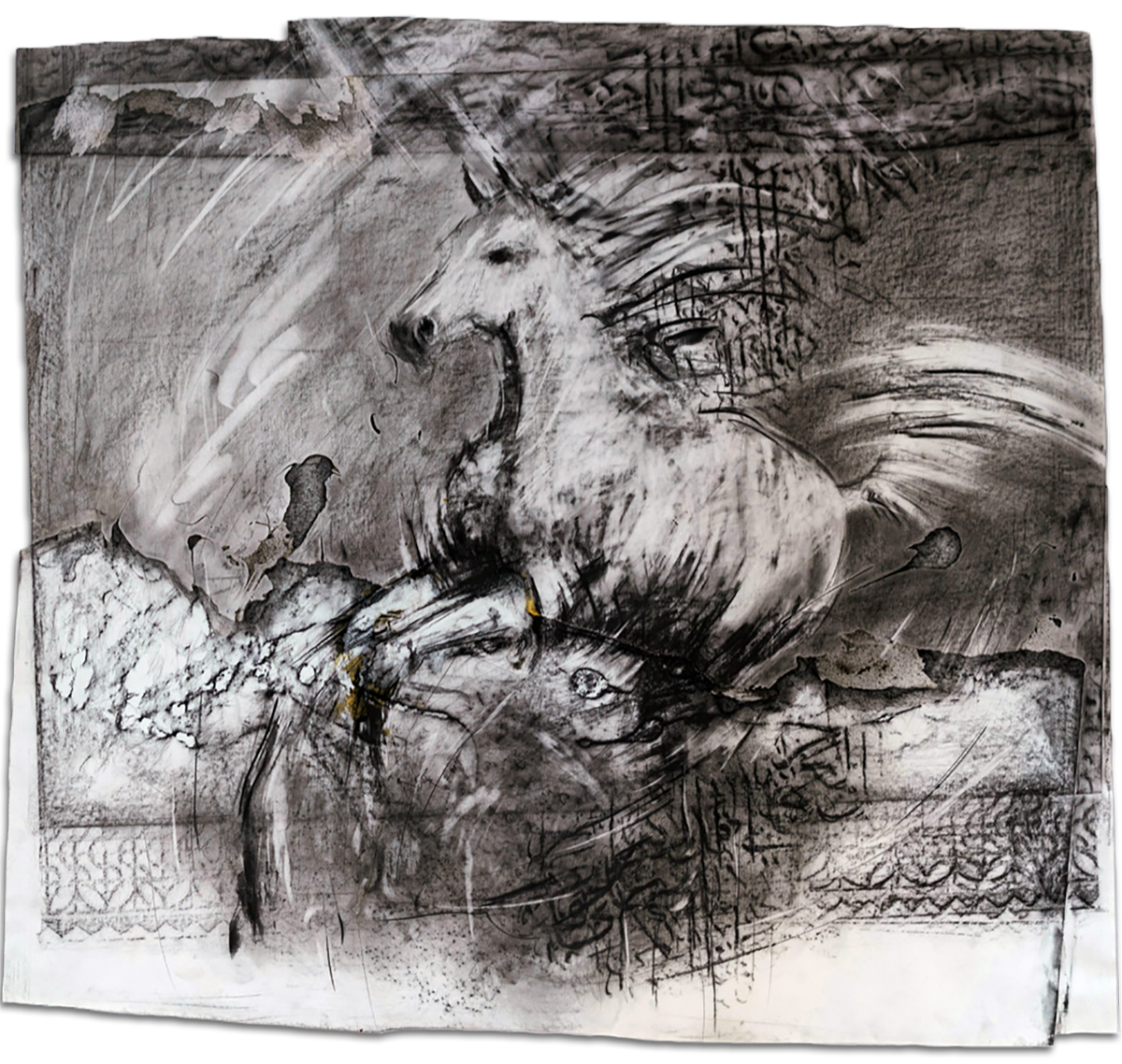
Rashid al-Khalifa, a graduate of Hastings College of Arts and Technology in Sussex, returned to Bahrain in 1978 with a newfound appreciation for landscape painting. Inspired by the English romantic painters such as J.M.W. Turner, al-Khalifa was inclined pay tribute to his country and began a series of oil paintings of the desert wadis, striking seashores, historical sites, and the subtlety of the sunrises and dramatic sunsets that filtered over Bahrain’s unique landscape. In Rumaitha Wadi (1995) the water’s reflection of the morning sky signifies the transformative power of nature and the inevitable interconnectedness of the elements. An ancient fort appears like an apparition in the distance, suggesting longing or foresight, where the seasonal occurrence of desert rain indicates cleansing and renewal.
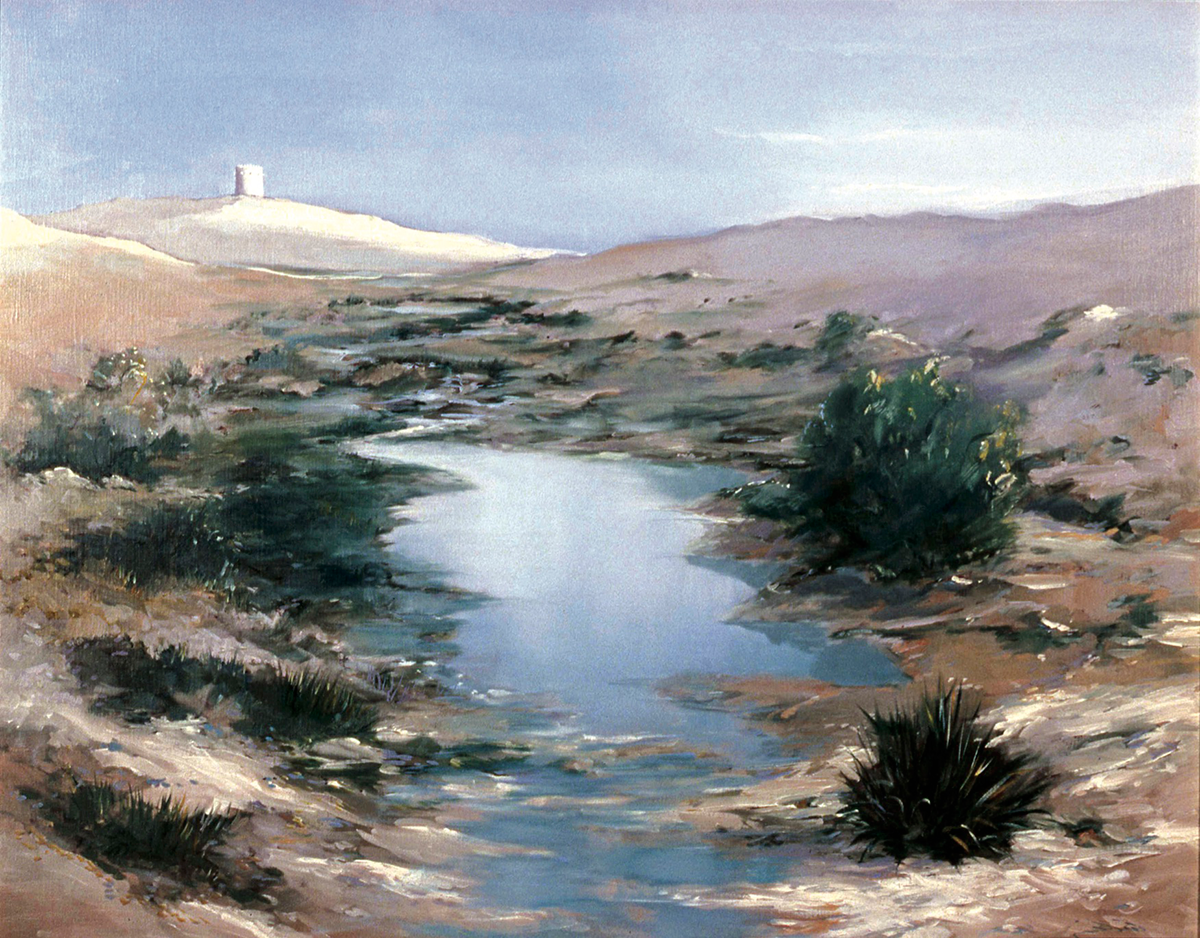
Al-Khalifa, Busaad, and Baqer were among the 20 founding members of the Bahrain Arts Society when it was established in 1983, and they were active in introducing, encouraging, and sharing new ideas and techniques with their peers. These artists were eager to gain inspiration and learn from one another’s experiences and to draw upon their landscape, culture, and history in their work. At the time, Bahrain was in the midst of a period of rapid economic development, having established itself as the banking capital of the Middle East and begun the process of diversifying its economy away from oil, of which it had limited supply compared to its neighbors. Banking, retail, tourism, and heavy industry, such as aluminum production, were at the forefront of Bahrain’s booming economy and signified a newfound sense of collective drive and vitality that many young artists, recently returned from their studies abroad, were eager to capitalize on. However, such rapid growth would have also had a profound effect on the landscape with the onset of major development projects. Abdulkarim al-Orrayed, a founding member of the Bahrain Contemporary Art Society established in 1960, is probably best known for the naivety of his oil paintings; vibrant scenes of Bahrain’s capital Manama’s traditional souq, tapestries of color grids resembling the lush green farm areas of coastal villages, and scenic representations of age-old trading practices, permeate his paintings. Yet in New Horizons (2012), he chooses to document significant events from Bahrain’s modern history that undoubtedly impacted the visual culture and heritage from which his pioneering artist peers typically drew inspiration.
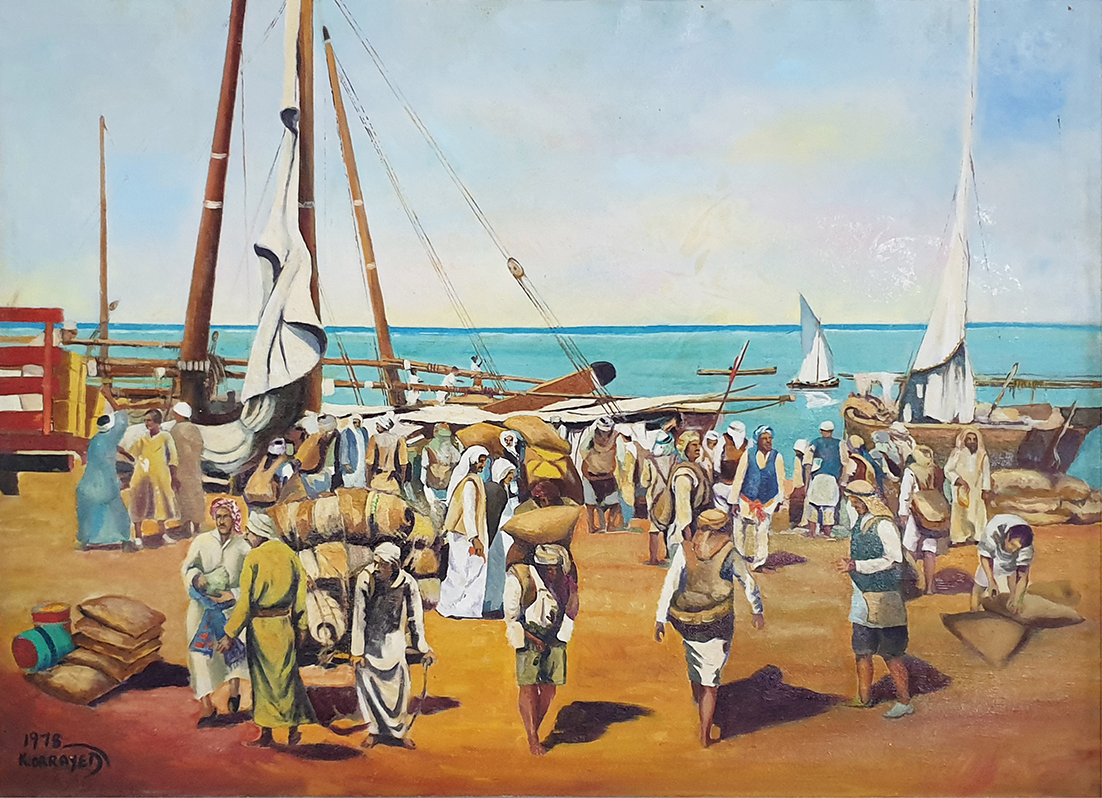
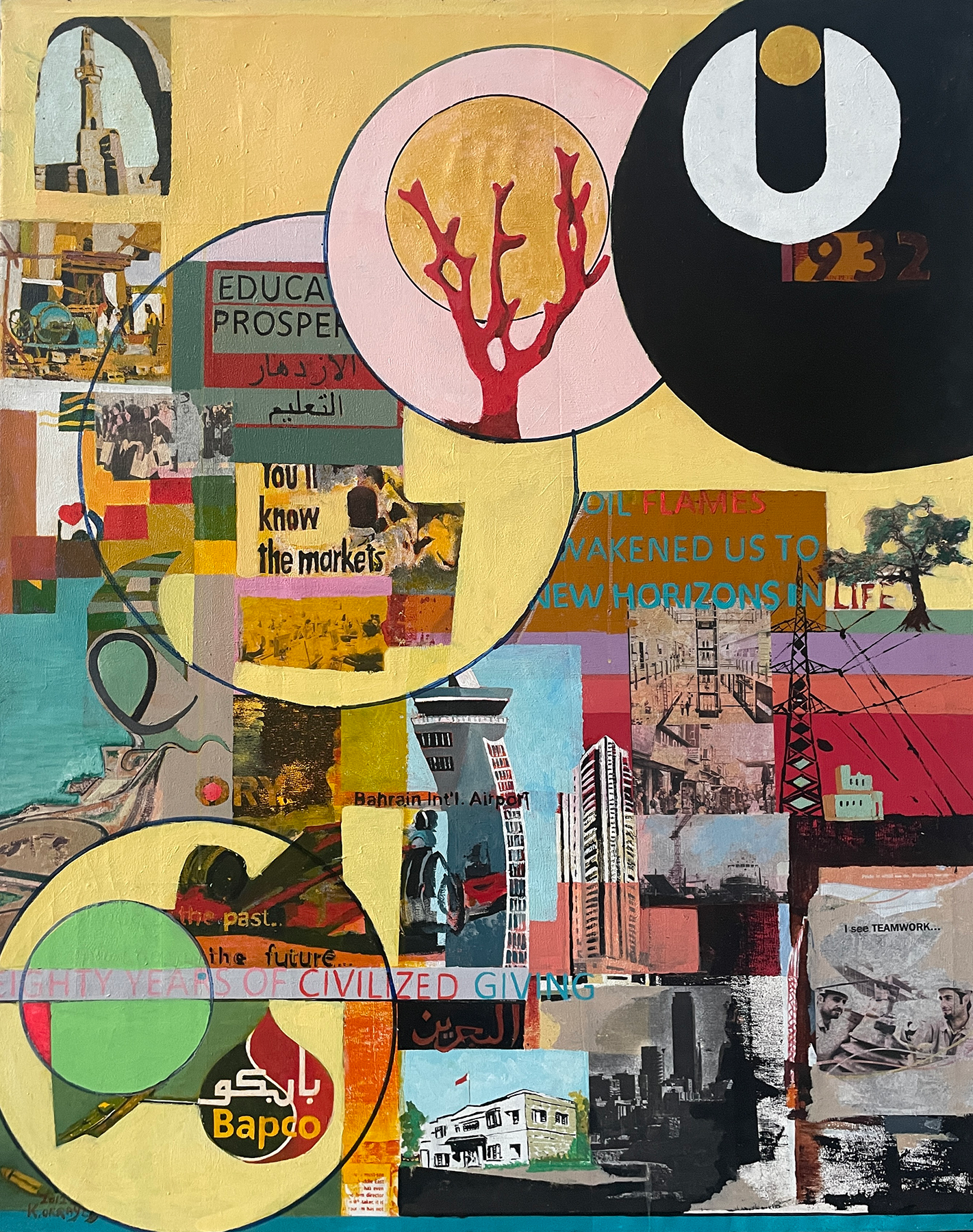
Rapid population growth, land scarcity, and increasing urbanization led to systematic land reclamation in Bahrain, which began in 1990 and continues today, putting further pressure on the fishing industry and the livelihoods of fishing communities. This in turn affected the ocean’s biodiversity, marine ecosystems, and water quality, increasing surface water pollution and changing the aesthetics of the visual landscape. Artists who had for so long drawn upon and identified with the landscape may have struggled to respond to such development and its impact on the environment. Nevertheless, al-Khalifa’s body of work, spanning more than 50 years, is by and large defined by the evolution of his style, which strongly correlates with the changes to his immediate landscape. Despite beginning his career as a landscape and figurative painter, aluminum is his choice of medium in his most recent works, a choice that is emblematic of his desire to embrace modernity and honor his country through his work. Second to oil, aluminum is the most exported product and Bahrain boasts the second largest aluminum smelter in the world (ALBA). One of al-Khalifa’s latest works, Haddrah (2023), pays homage to the once-thriving but now diminishing fishing industry, recreating a traditional “fish trap” with its meandering design and repetitive structure. However, al-Khalifa employs stainless steel columns to replace the traditional palm and reeds, and it is their pristine, lustrous nature that entices the viewer to wander inside, permitting the flow of movement and the reflection of light as one navigates the work. A typically robust material is transformed into a seemingly delicate structure, glistening as it stands like a monument to a timeless trade.
The environmental impact of development
Decades of rapid development in Bahrain and heavy dependence on groundwater resources had a drastic effect on the terrestrial sweet water springs. Once-plentiful reserves of groundwater began to dwindle, lowering the aquifer levels and causing natural springs to stop flowing. Bahrain has had to increasingly depend on desalination plants for its water supply. Furthermore, land reclamation projects and over-exploitation of groundwater resources resulted in the drying up of submarine sweet water springs, leading to seawater incursion into these aquifer systems. This directly affected rich oyster beds and marine life and the traditions and customs that were synergetic with the environment. Much of ethnomusicologist Hasan Hujairi’s work explores “histories on the verge of loss,” including those of his native country, and in projects such as Otolithe Response Series (2021-2022), a collaboration with animator Christine Rebet, he incorporates sounds of the music tradition known as Fijiri, or “sea music,” an all-male chorus with minimal percussion, which is often associated with pearl diving.
Like Hujairi, a new generation of artists have begun to emerge that consider the histories of their predecessors and tackle the challenges that have arisen with the loss of their natural environment, specifically the relationship to water. By contemplating their ancestral past and considering their imminent, uncertain future, a commonality exists within their artistic practice that encompasses both the subtlety of recollection and the veracity of documentation. What arises are identifications with loss, longing, and the ambiguity of memory.
Much of Mariam al-Noaimi’s work explores rapid urban development, its impact on the spatial environment, and the way this affects communities and societies. Shifting Waters (2021) layers photographs of al-Safahiya water spring in Nabih Saleh, once full, now depleted, and in doing so, calls to mind the permanence of location as well as the transitions of life. The resulting images are poetic interpretations of visual documentations, narratives that consider the effect of the presence and absence of water. Consequently, al-Noaimi provides a framework in which to call attention to urbanization, climate change, social transformations, and the effect that these rapid changes have on water, particularly after the discovery of oil.
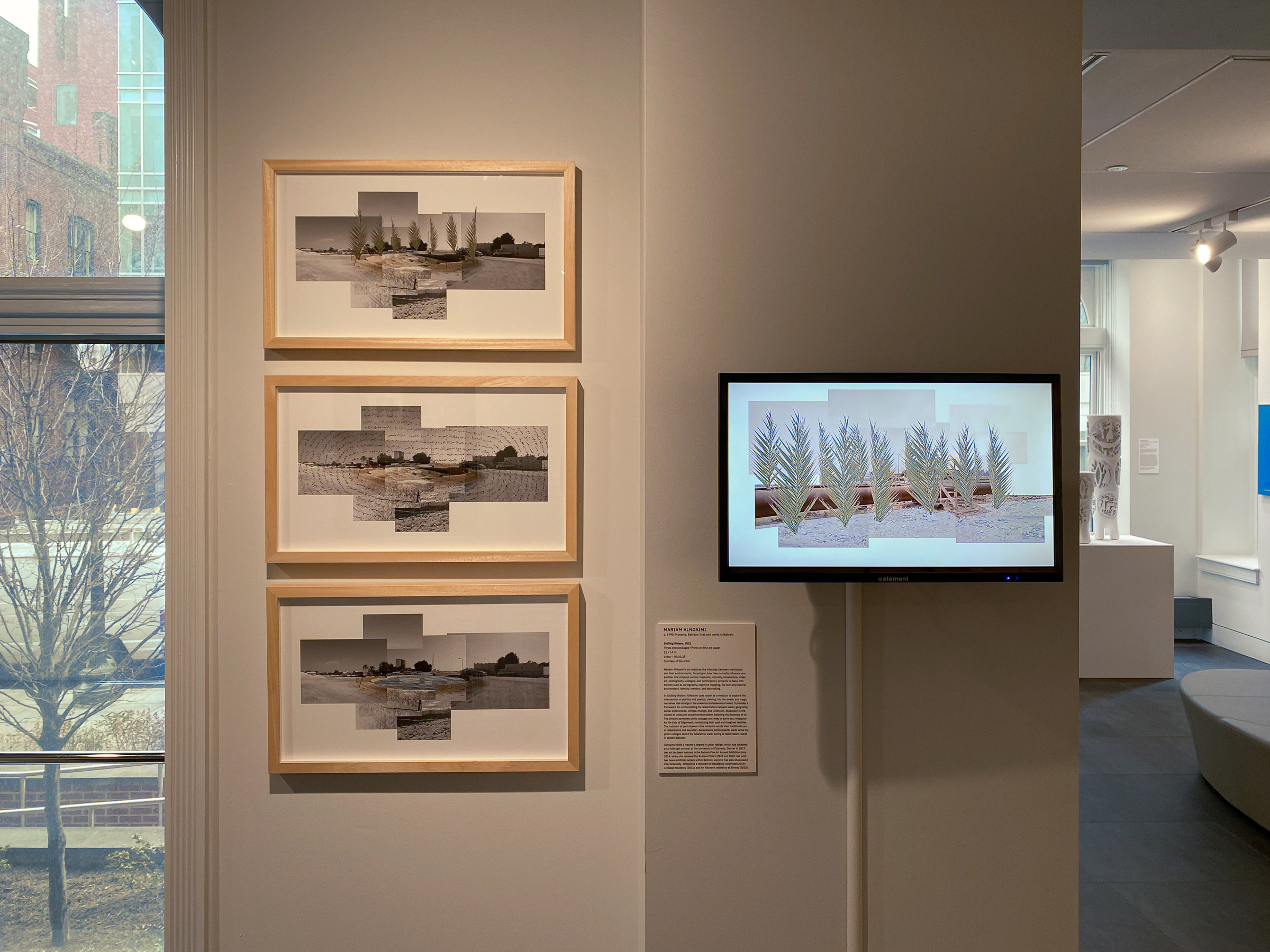
Nasser al-Zayani’s Watering the Distant, Deserting the Near (2016-ongoing), which was awarded the Richard Mille Art Prize at the Louvre Abu Dhabi in 2021, presents slabs made of sand that incorporate traces of Arabic inscriptions. The chosen text, a line of poetry by a Bahraini poet that recalls the freshwater spring Ain Adhari, transpires as a relief over the surface and each piece. Displayed like ancient artifacts in a museum, these tablets are reminiscent of the fragments of ancient clay pottery that are often discovered as one traverses the ancient ruins and burial sites around Bahrain.
Once the largest sweet water spring in the country, Ain Adhari, now completely dry, attracted people from all over the island. Al-Zayani remembers visiting it as a child but his memories of that experience faded with time, and like many of his generation, knowledge of these culturally significant landmarks exists through stories and the memories of those who lived through them. The fragility of nature, the faintness of al-Zayani’s childhood memories, and the desire for preservation are all echoed in the ephemerality of these artifacts, which perhaps, if ever pieced together, would tell a story of a forgotten time.
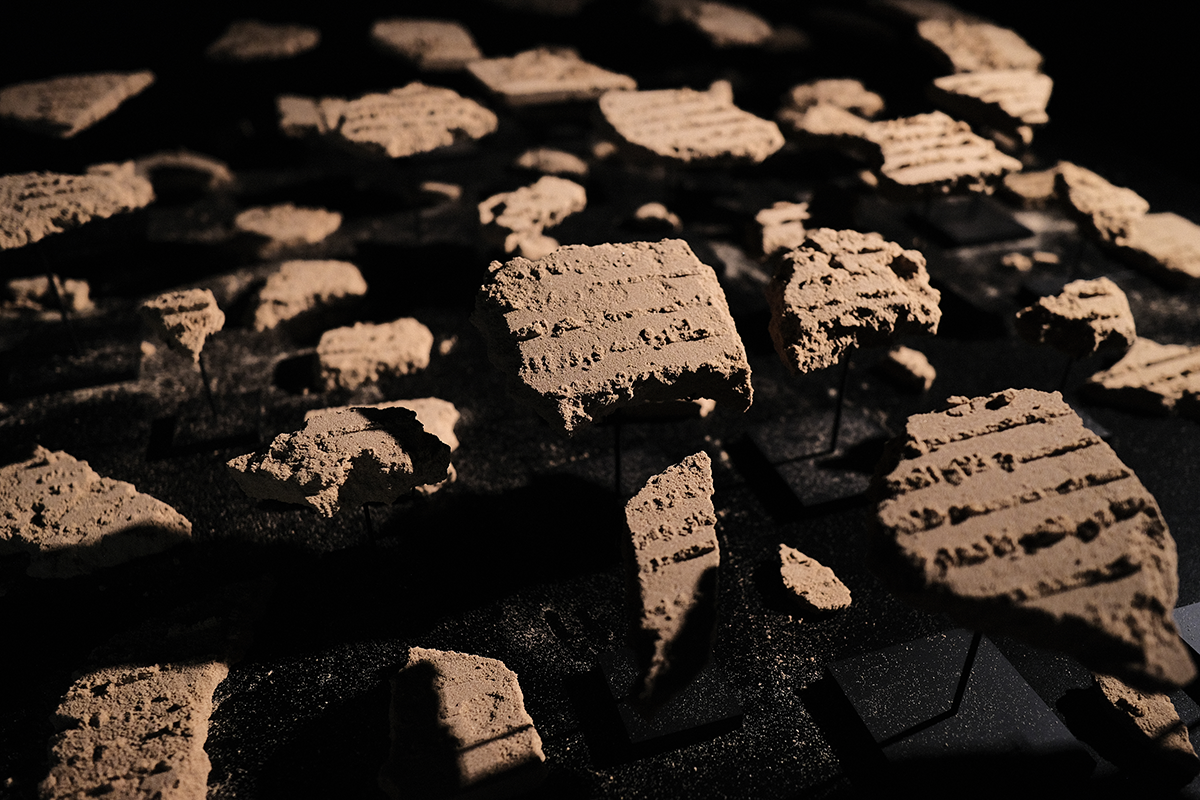
Inspired by the mythology of Ain Adhari, Mashael al-Saie’s Barren Spring incorporates photographic prints and glass sculptures to consider the folklore of the legendary spring. Despite there being multiple mythologies associated with Adhari, al-Saie reflects on “The Myth of the Maiden Spring,” a cautionary tale wherein a heroine is a victim of sexual violence and upon weeping, the heroine is transformed into an everlasting spring. A series of 13 clear glass sculptures encompass frankincense and morph into organic formations, representations of the maiden’s tears. It is as if these otherworldly objects have arisen from beneath the dry earth, from within the subterranean lands of the ancient abzu, frozen in time as the reach the surface, encapsulating the sanctity, mystery, and history of these ancient lands.

Yasmin Sharabi is an artist and curator whose work acknowledges the complexities of identity by exploring aspects of heritage, inheritance, and culture, and documenting where these overlap and intersect, to create new narratives. She is currently the director of the RAK Art Foundation and continues to work with artist and collector Sheikh Rashid bin Khalifa al-Khalifa, project managing his exhibitions and overseeing his private collection.
“The Sea of Life: Modern and Contemporary Art from The Kingdom of Bahrain,” co-curated by Hayfa Aljishi and Lyne Sneige and including works by Abdulkarim al-Orrayed, Rashid al-Khalifa, Mariam al-Noaimi, and Mashael al-Saie, is on display at the Middle East Institute in Washington, DC until March 26, 2024. For more information, please visit the MEI website.
Main photo: Bahraini artist Mariam al-Noaimi at the opening of "The Sea of Life: Modern and Contemporary Art from The Kingdom of Bahrain." Photo by Jason Dixson Photography.
The Middle East Institute (MEI) is an independent, non-partisan, non-for-profit, educational organization. It does not engage in advocacy and its scholars’ opinions are their own. MEI welcomes financial donations, but retains sole editorial control over its work and its publications reflect only the authors’ views. For a listing of MEI donors, please click here.












